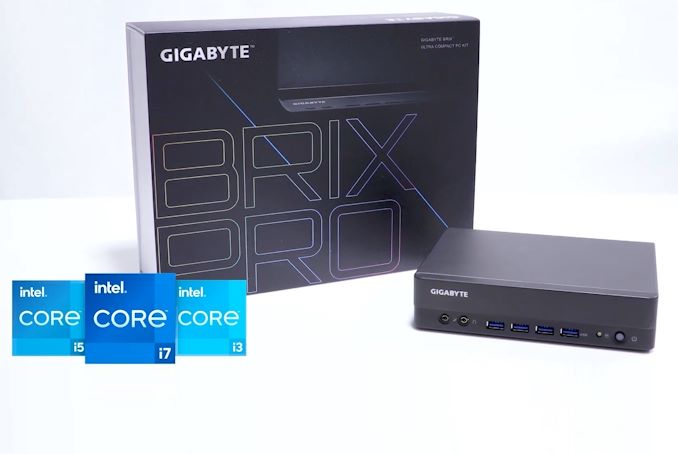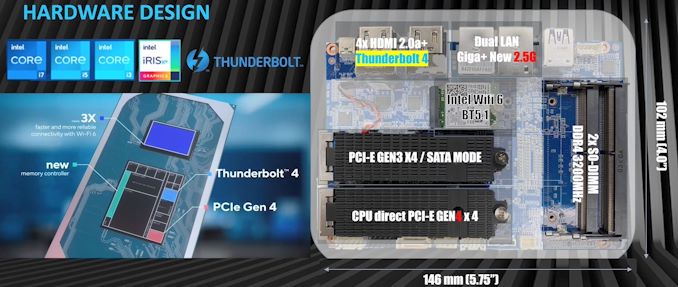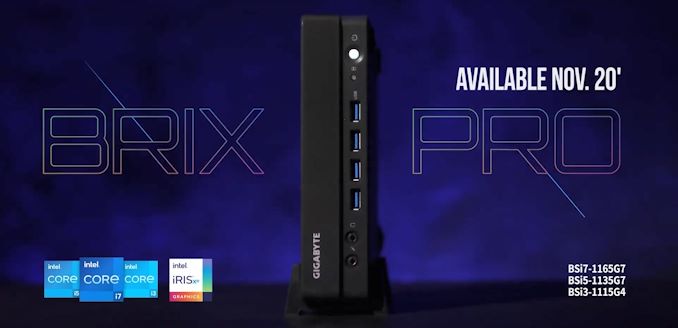GIGABYTE Unveils BRIX PRO Mini-PCs with Tiger Lake-U
by Ganesh T S on September 29, 2020 9:30 PM EST
Intel's Tiger Lake launch was focused on ultrabooks and notebooks, as various SKUs with TDP ranging from 7 to 28W were launched. The performance of Intel's low-power parts (U- and Y-series) have been good enough to land them inside small and ultra-compact form-factor systems. These systems have become a big hit in the market (not least, Intel's own NUC systems) since they gained prominence in the early 2010s. Vendors such as ASRock, ASUS, ECS, and GIGABYTE also jumped on this bandwagon to market 'NUCs' under their own branding. GIGABYTE was one of the early ones to do so with their BRIX series of mini-PCs. These SFF and UCFF systems find applications in multiple areas including content creation, productivity, and gaming, as well as embedded systems applications such as digital signage.
Intel's Tiger Lake-based NUCs (Panther Canyon and Phantom Canyon) are an open secret in tech circles. ASRock Industrial's Tiger Lake NUCs such as the NUC BOX-1165G7 have also been hinted at in Intel's marketplace - a retail follow-up to the embedded market-focused iBOX 1100 and NUC 1100 solutions. GIGABYTE, however, became the first vendor to officially announce Tiger Lake-based mini-PCs targeting the retail market with the launch of the GIGABYTE BRIX PRO. Three models (BSi3-1115G4, BSi5-1135G7, and the BSi7-1165G7) are being introduced. Their specifications are summarized in the table below.
| GIGABYTE BRIX PRO (Tiger Lake-U) Lineup | ||||
| Model | BSi3-1115G4 | BSi5-1135G7 | BSi7-1165G7 | |
| CPU | Intel Core i3-1115G4 2C/4T 1.7 - 4.1 GHz (3.0 GHz) 12 - 28 W (28W) |
Intel Core i5-1135G7 4C/8T 0.9 - 4.2 GHz (2.4 GHz) 12 - 28 W (28W) |
Intel Core i7-1165G7 4C/8T 1.2 - 4.7 GHz (2.8 GHz) 12 - 28 W (28W) |
|
| GPU | Intel® UHD Graphics for 11th Gen Intel® Processors (48EU) @ 1.25 GHz | Intel® Iris® Xe Graphics (80EU) @ 1.3 GHz | Intel® Iris® Xe Graphics (96EU) @ 1.3 GHz | |
| DRAM | Two DDR4 SO-DIMM slots Up to 64 GB of DDR4-3200 in dual-channel mode |
|||
| Motherboard | 3.5" SBC | |||
| Storage | SSD | 1x M.2-2280 (PCIe 4.0 x4 (CPU-direct)) 1x M.2-2280 (PCIe 3.0 x4 or SATA) |
||
| DFF | 1 × SATA III Port (for SATA DOM? No space for 2.5-inch drive?) | |||
| Wireless | Intel Wi-Fi 6 AX201 2x2 802.11ax Wi-Fi + Bluetooth 5.1 module |
|||
| Ethernet | 1 × GbE port (Intel I219-V) 1 × 2.5 GbE port (Intel I225-V) |
|||
| USB | Front | 4 × USB 3.2 Gen 2 Type-A | ||
| Rear | 2 × USB 3.2 Gen 2 Type-A | |||
| Thunderbolt | 1 x Thunderbolt 4 (Type-C Rear Panel) | |||
| Display Outputs | 4 × HDMI 2.0a 1 × DisplayPort 1.4 (using Thunderbolt 4 Type-C) (Only four simultaneous display outputs are supported) |
|||
| Audio | 1 × 3.5mm audio jack (Realtek ALC255) | |||
| PSU | External (135W) | |||
| Warranty | Typical, varies by country | |||
| Dimensions | Length: 196.2 mm Width: 140 mm Height: 44.4 mm |
|||
| MSRP | ? | ? | ? | |
THe Tiger Lake-based BRIX PRO eschews the NUC form-factor (approx. 4"x4" / 100mm x 100mm) for a 3.5" single-board computer one that is popular in embedded markets. The motherboard's actual dimensions are 5.75" x 4" (146mm x 102mm), and the system's dimensions come in at 196.2mm x 44.4mm x 140mm. At 1.16L in volume, it is still a compact machine. The Tiger Lake-U processors in the BRIX PRO units are configured to run at their maximum cTDPup of 28W.
One of the unique aspects of the units is the availability of 4x HDMI 2.0 ports - each capable of driving a 4Kp60 display. In addition, a Thunderbolt 4 port (with a display output capability of 8Kp60) is also available. The system can drive four of those five display outputs simultaneously. Segments of the chassis are metallic, allowing for the Wi-Fi antenna to magnetically clasp to it.
The Tiger Lake-U processor can be configured with different PL2 values depending on the power delivery circuitry. GIGABYTE believes that the robustness of its board design, coupled with the 135W external power adapter can sustain upwards of 70W for the PL2 setting.
Retail availability of the new BRIX PRO units is expected in November 2020. Pricing hasn't been announced yet. GIGABYTE also hinted at the possibility of UCFF BRIX systems sporting Tiger Lake-U processors reaching the market soon.
Source: GIGABYTE














42 Comments
View All Comments
close - Thursday, October 1, 2020 - link
It might be far better, for the relatively few that use it. I can turn your argument on your head and say I have that SD slot on basically every laptop I bought over the past decade and probably only used it a couple of times. Just as solid as the "I need it so it should be there" argument. They're just not as used as you might want to think and for the manufacturer it makes sense to cut it, even when angering you.PixyMisa - Wednesday, September 30, 2020 - link
You can get some tiny microSD to USB adapters that barely extend beyond the USB port.A proper card slot would be better, but that will work if you don't need to read a full-sized card.
Srikzquest - Wednesday, September 30, 2020 - link
I do have an adapter for these kind of systems but that's the pain (not native and maintaining adapters - making sure they are not lost) and SD Cards are not going the way of Fire wire port anytime soon. Pretty much all DSLR and mirrorless cameras still need SD cards.Spunjji - Wednesday, September 30, 2020 - link
Adaptors dying is also an issue - I've had two of the smaller USB-3 to SD card adaptors die on me, just through normal usage. Both were reputable brands and neither was particularly cheap (~£30).dihartnell - Tuesday, September 29, 2020 - link
Author should proofread his article. The BSi7-1165G7 doesn't have an AMD CPU.basroil - Tuesday, September 29, 2020 - link
Yea, I was highly confused when a Ryzen 4300 was paired with integrated Xe....Klimax - Wednesday, September 30, 2020 - link
Bit funny considering name itself contains id of CPU inside.sorten - Tuesday, September 29, 2020 - link
Weird design choices, other than the AMD CPU :)135W power supply for a system running 28W CPU. 4 HDMI ports?
The form factor interests me. Obviously you could sustain a higher TDP than you'd be able to in a laptop, so it might be a good system to pair with an eGPU for gaming (as pictured).
basroil - Tuesday, September 29, 2020 - link
28W means their thermal design is 28W and chips designed to support 28W continuous... Instantaneous power draw for the GT4 variants is 65A (intel data sheet 631121), and even assuming just 1V input that would put you at 65W with just the CPU. Usually those get filtered out on the motherboard, but if they wanted to cheap out on the MB cap design they could easily just get a massively overpowered PSU to compensate (cheap but large PSU). Add in ~15W peak for each SSD, ~20W for USB+wifi, ~5W+ for memory and things seem a bit more reasonable right?nils_ - Wednesday, September 30, 2020 - link
The thunderbolt / USB4 also factors into the budget there I would think.